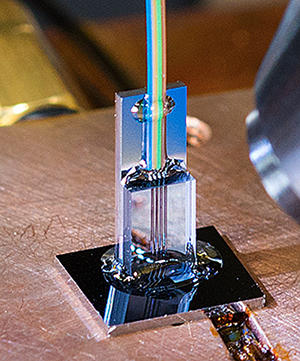PML Photonics Priority: Metrology for Advanced Manufacturing

Photonic technologies are critically important to advanced manufacturing and advanced communications, including the components, devices, and systems that will provide the foundation for the future Internet of Things. Increasingly, advanced communications will be performed using photonic integrated circuits (PICs) to complement electronic integrated circuits, and widespread use of photonic sensors will provide new, more accurate measurements based on the subtleties of quantum physics.
One of the Key Recommendations in a recent report from the National Research Council states that "the U.S. government and private industry, in combination with academia, need to invent technologies for the next factor-of-100 cost-effective capacity increase in long-haul, metropolitan, and local-area optical networks." As of mid-2015, several Federal agencies have partnered to invest $110M over five years in the Integrated Photonics Institute for Manufacturing Innovation (IP-IMI) a fabrication and research effort to advance the design and manufacture of photonic integrated circuits.
A successful national effort will require a robust measurement-science infrastructure to monitor and control manufacturing processes, to accurately specify photonic-material quality and device performance within the supply chain, and to provide the underlying research for new devices and applications.
In response to these needs, PML plans to:
- Provide reference materials and reference data on the linear and nonlinear optical properties of classical photonic materials and new engineered and carbon-based photonic materials. Demonstrate novel integrated photonic measurement devices that leverage the properties of these new materials.
- Advance primary physical measurement standards based on NIST measurement science successes in quantum and optical physics, such as single-photon sources and detectors for SI traceability of optical power.
- Advance the fabrication, manufacturability, dissemination, and commercialization of micro and nanoscale classical and quantum photonic circuits, sensors, and coherent and incoherent light sources, and leverage the capabilities of the Integrated Photonics Institute within the National Network for Manufacturing Innovation (NNMI)to help achieve these goals.
- Incorporate mechanical components into integrated photonic devices to create novel quantum and classical opto-mechanical devices for use as both sensors and standards.
Specific goals include:
- Demonstration of a room-temperature, carbon-photonics-based broadband, high-sensitivity optical detector.
- Accurate index-of-refraction measurements and reference materials for critical infrared materials, disseminated through NIST Standard Reference Data and Standard Reference Material Program.
- Development and dissemination of new photonic integrated circuits (PICs) as test structures to enable improved PIC manufacturing by the IP-IMI and other stakeholders.
- A quantum opto-mechanical self-calibrating temperature sensor and a library of fabricatable opto-mechanical components.
- Photonic multifunctional sensors for SI-traceable dissemination.
- Demonstration of a photonic fundamental high-vacuum standard for application to integrated photonics and electronics manufacturing quality control.
- New research-focused equipment and methodologies to advance metrology for integrated photonics and nanophotonics fabrication.

